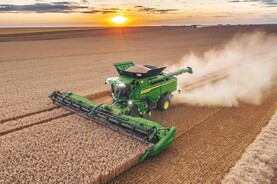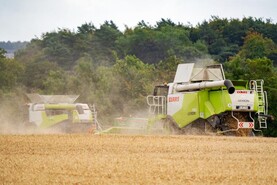Scientists in Rothamstead Research in the UK are seeking farmers’ help to decide whether the type of headland on your farm’s field could affect the yield of the crop.
They want to know if flower-rich margins, hedgerows or tree lines are helping improve yield and are asking farmers to help by sending them GPS data collected at harvest.
In return, the farmers will be given a summary of the findings, with tips on how they might increase production.
Yield and landscape features
Dr Helen Metcalfe, who is collating the data, said different types of field boundaries could help to reduce the yield decline at field edges.
“By linking the yield monitor data collected by GPS-enabled combine harvesters with the presence of different landscape features, we will try to determine whether yield decline towards the edge of fields is associated with certain types of boundaries,” she explained.
“Likewise, we will also identify whether features known to support pollinators and other beneficial wildlife are having a positive effect on yield in the nearest parts of the crop.

“We’d be really grateful if any farmers with yield monitor data from their combines would share it with us.”
Speaking to the Irish Farmers Journal, Dr Metcalfe said the EcoStack project is a European-wide study.
“It would be really great to have some Irish farmers involved,” she added.
Biodiversity
The EcoStack project is hoping that information on the location, quality and quantity of landscape features such as hedgerows or wildflowers, when linked to yield maps, will give the clearest indication yet on the benefit of on-farm biodiversity.
Data from any crop can be sent to the researchers.
More information on how to take part, including simple instructions on how to download combine data, can be obtained from this site or by emailing helen.metcalfe@rothamsted.ac.uk.
Read more
Tillage Management: important decisions to be made
From the Tramlines: spring crops moving in great conditions
Boortmalt to cut malting barley contracts
Scientists in Rothamstead Research in the UK are seeking farmers’ help to decide whether the type of headland on your farm’s field could affect the yield of the crop.
They want to know if flower-rich margins, hedgerows or tree lines are helping improve yield and are asking farmers to help by sending them GPS data collected at harvest.
In return, the farmers will be given a summary of the findings, with tips on how they might increase production.
Yield and landscape features
Dr Helen Metcalfe, who is collating the data, said different types of field boundaries could help to reduce the yield decline at field edges.
“By linking the yield monitor data collected by GPS-enabled combine harvesters with the presence of different landscape features, we will try to determine whether yield decline towards the edge of fields is associated with certain types of boundaries,” she explained.
“Likewise, we will also identify whether features known to support pollinators and other beneficial wildlife are having a positive effect on yield in the nearest parts of the crop.

“We’d be really grateful if any farmers with yield monitor data from their combines would share it with us.”
Speaking to the Irish Farmers Journal, Dr Metcalfe said the EcoStack project is a European-wide study.
“It would be really great to have some Irish farmers involved,” she added.
Biodiversity
The EcoStack project is hoping that information on the location, quality and quantity of landscape features such as hedgerows or wildflowers, when linked to yield maps, will give the clearest indication yet on the benefit of on-farm biodiversity.
Data from any crop can be sent to the researchers.
More information on how to take part, including simple instructions on how to download combine data, can be obtained from this site or by emailing helen.metcalfe@rothamsted.ac.uk.
Read more
Tillage Management: important decisions to be made
From the Tramlines: spring crops moving in great conditions
Boortmalt to cut malting barley contracts







 This is a subscriber-only article
This is a subscriber-only article










SHARING OPTIONS: